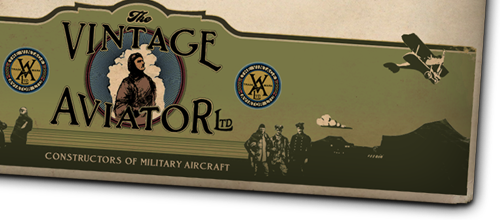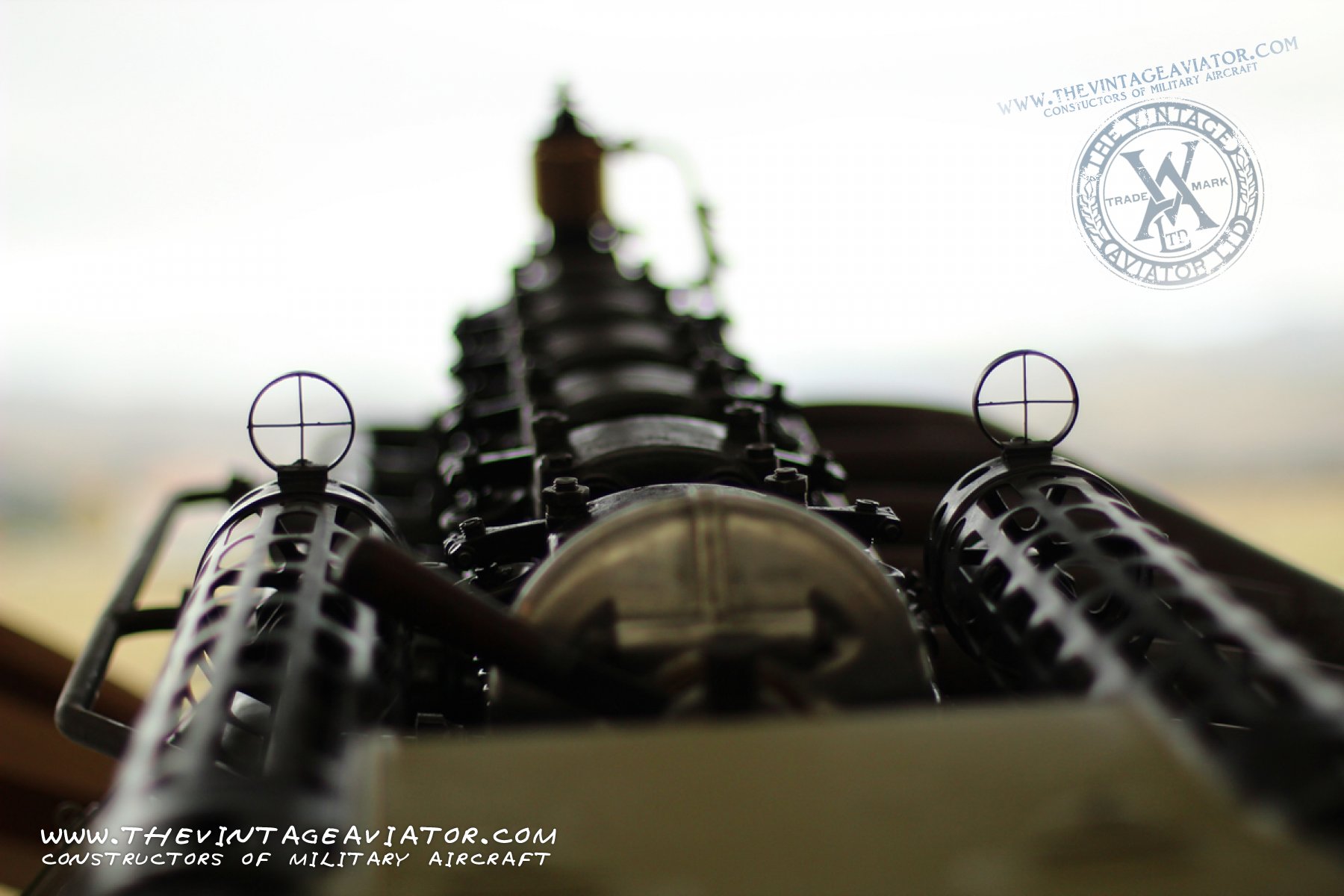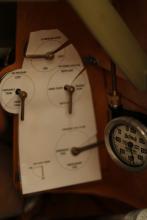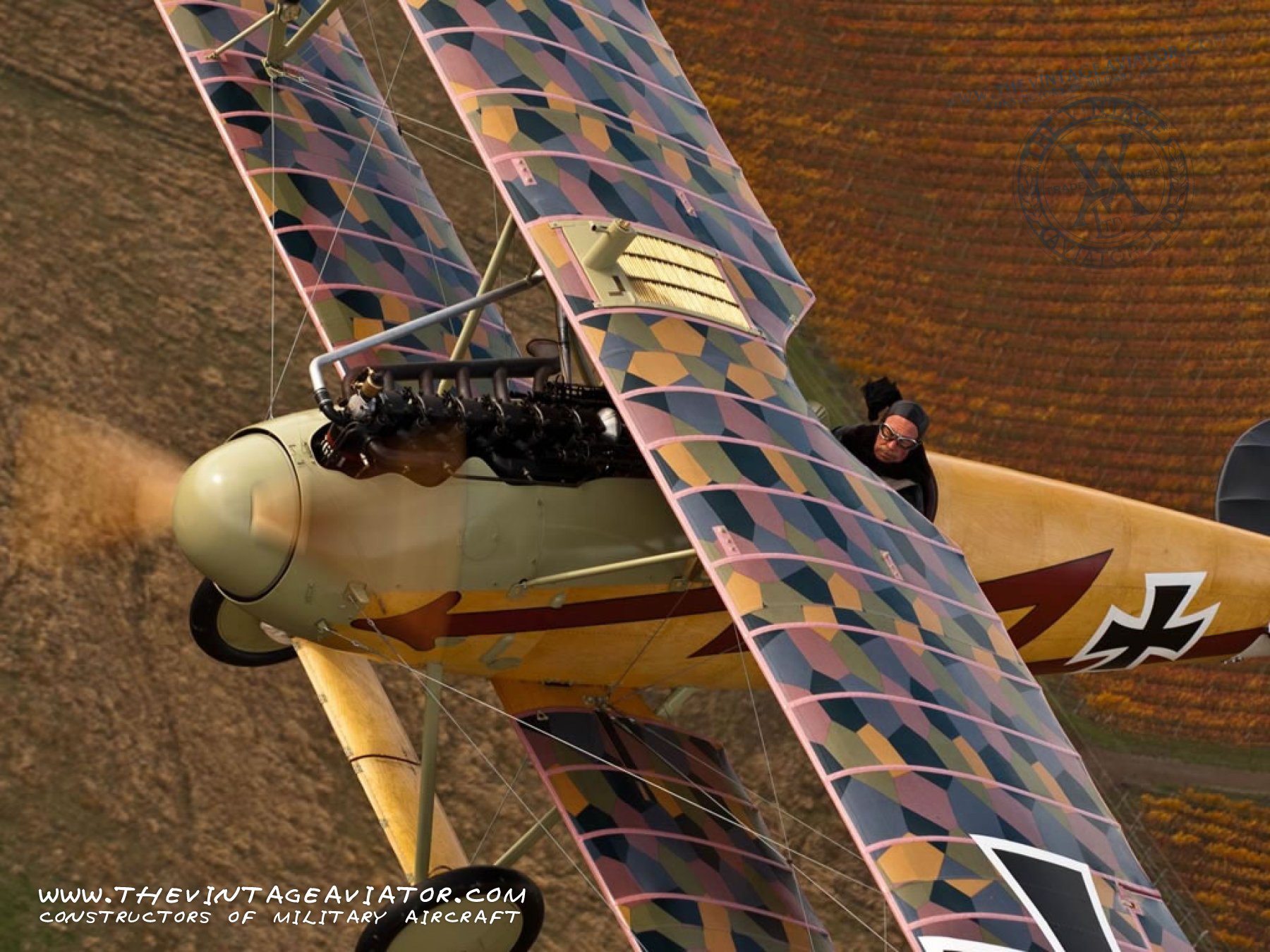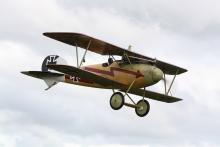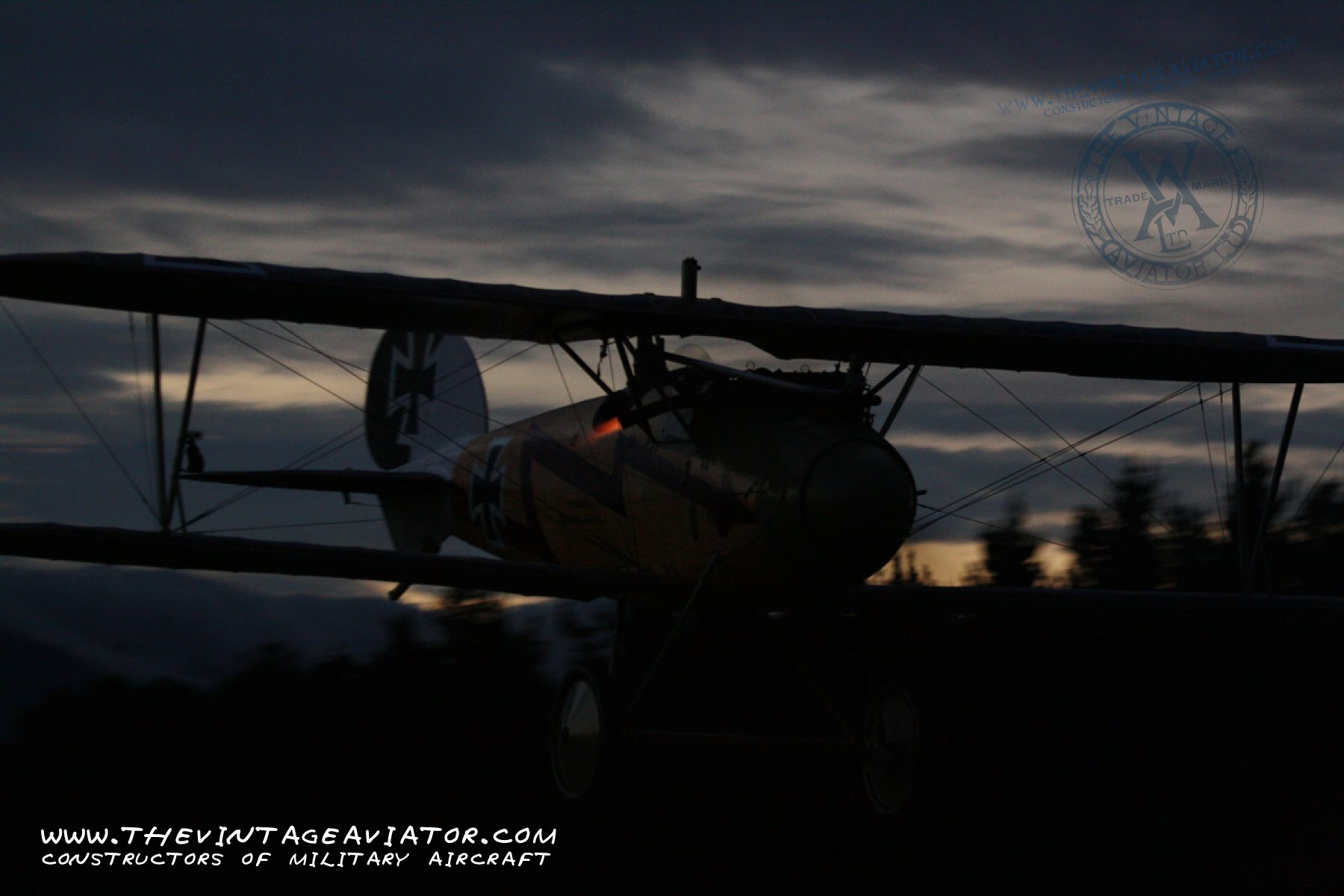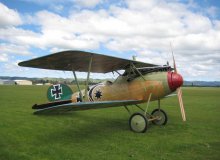You are here
Notes on Flying the D.Va
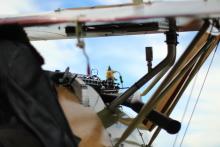 Two years in the making gives one plenty of time to read about a plane and do a little research. In the case of the Albatros, I am glad I had experience with the type (flying the Rhinebeck replica in New York) otherwise I may have formed a very negative opinion of the aircraft. After all it suffered from numerous structural failures in its first three months in service, many pilots including Josef Jacobs didn't particularly like it, in fact he said, "It is a bit unstable".
Two years in the making gives one plenty of time to read about a plane and do a little research. In the case of the Albatros, I am glad I had experience with the type (flying the Rhinebeck replica in New York) otherwise I may have formed a very negative opinion of the aircraft. After all it suffered from numerous structural failures in its first three months in service, many pilots including Josef Jacobs didn't particularly like it, in fact he said, "It is a bit unstable".
“It is a bit unstable”
Just knowing that the aircraft was pushing the limits of technology at the time is cause enough to respect the design (read -be afraid of!) after all the aircraft was capable of exceeding its design limits, it has a big powerful engine and the airframe is lightly built and minimally braced, and its slippery. The sleek design allows speed to build quite quickly.
Pre-flight
So - getting ready to fly it! First it must be serviced. Fill the cooling system with water, 27 litres of it. It must be drained each night because there is no proper seal between the water in the water pump and the engine oil. The water pump sits at the bottom of the engine crankcase and the water pump drive shaft is lubricated and sealed by grease under pressure from a greaser mounted in the cockpit. This pressurized grease forms the barrier between coolant liquid and oil in the engine's sump. The pilot must twist the greaser handle every so often in flight to make sure these two fluids are kept separated.
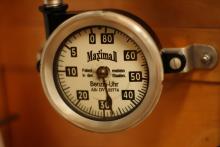 After servicing with water one of the cowls is removed to service the two fuel tanks. It is imperative to visually check the fuel level since the gauge isn't very accurate and there is no indicator fitted to the emergency tank, which drains down into the main tank over time. If this happens the air system tends to become filled with fuel - a condition which makes the engine-driven air pump look like a Greek fountain! Filling the cockpit with fuel or if left unnoticed spraying the engine and pilot with fuel just as the engine springs to life!
After servicing with water one of the cowls is removed to service the two fuel tanks. It is imperative to visually check the fuel level since the gauge isn't very accurate and there is no indicator fitted to the emergency tank, which drains down into the main tank over time. If this happens the air system tends to become filled with fuel - a condition which makes the engine-driven air pump look like a Greek fountain! Filling the cockpit with fuel or if left unnoticed spraying the engine and pilot with fuel just as the engine springs to life!
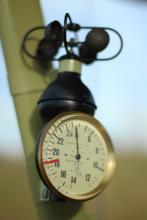 The next step is to "decompress" the engine by moving a lever that reduces the engine compression for starting. Then the cowlings can be put back on and the engine started. The booster magneto is sufficient to start the engine without even hand swinging the prop on most occasions. The coolant warms slowly even with the radiator shutters closed and the engine only runs well when warm so proper temperature is critical.
The next step is to "decompress" the engine by moving a lever that reduces the engine compression for starting. Then the cowlings can be put back on and the engine started. The booster magneto is sufficient to start the engine without even hand swinging the prop on most occasions. The coolant warms slowly even with the radiator shutters closed and the engine only runs well when warm so proper temperature is critical.
“oil and grease... will be thrown in your face”
As the engine warms up the pilot has plenty of time to contemplate the flight and what to look for; mind the airspeed don't pull to many G's watch the temperature, twist the greaser, keep the air pressure up. and if all the oddities aren't enough to keep you busy, you can watch the engine in operation, without a firewall the engine is in plain sight just ahead of the pilot below the guns. The overhead cam has an exposed valve mechanism which is fascinating to watch, you can see the valves, springs and rockers all moving, dripping with oil and grease which inevitably will be thrown in your face throughout the flight, making goggles a must have. It's a machine that offers all of the senses a little something; just as it starts cold water splashes in your face as the upper wing radiator leaks water into the cockpit a little later on the taxi to take off this will be near scalding water that is dribbling out of the radiator.
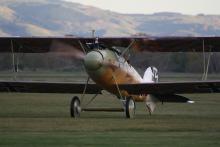 As you taxi you realize this is a heavy machine that likes to roll and has no brakes, the engine just ticks over at 500 RPM and even then the machine creeps ahead at a brisk walk downwind, better keep that in mind landing. It's also very hard to steer without a keel fixed to the tailskid and without a steerable skid. A simple rounded shoe on the bottom of the tailskid offers minimal resistance, nil braking action and very little stabilizing effect on roll out.
As you taxi you realize this is a heavy machine that likes to roll and has no brakes, the engine just ticks over at 500 RPM and even then the machine creeps ahead at a brisk walk downwind, better keep that in mind landing. It's also very hard to steer without a keel fixed to the tailskid and without a steerable skid. A simple rounded shoe on the bottom of the tailskid offers minimal resistance, nil braking action and very little stabilizing effect on roll out.
“The engine has a tremendous amount of power...”
As the take off is started you are amazed at how much movement can be seen in the upper wing relative to the fuselage, the first instinct is to close the throttle and look for some missing brace wires. Fortunately a little experience with this type prepared me for this, and I kept going. The movement comes from the lack of cross bracing in the center section area and the monocoque fuselage changing shape as it becomes airborne. The engine has a tremendous amount of power and the Albatros climbs well, you need to look out on the Right hand wing strut to see the airspeed, a small wind driven anemometer displays the airspeed in Kilometres Per Hour. The airspeed indicator in itself is a work of art.
Flight
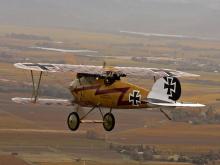 In flight the D.Va performs well, not nearly as well balanced and harmonized as the RAF SE.5a though. The ailerons are heavy and the roll rate isn't very spectacular, the elevator is very sensitive, almost too sensitive while the rudder is less than adequate. For me the best part is the engine, something about it gives the feeling of security, it has a healthy rumble and good throttle response. It is difficult to keep the engine warm on cold days and is easy to overheat on warm days, the radiator shutters seem to be either full open or closed and even then there isn't enough temperature control. During the flight your other senses take part, as the engine warms and fluids start oozing out there is the occasional whiff of burning oil or cooking grease each of these comes with its own visual indicator as well, a small puff of smoke or hot droplet in the face. With minimal instruments, only the airspeed indicator on the strut a Tachometer in front of you and a small air pressure gauge to measure fuel tank pressure there isn't much to monitor, no oil temperature or oil pressure indication and no electrical system.
In flight the D.Va performs well, not nearly as well balanced and harmonized as the RAF SE.5a though. The ailerons are heavy and the roll rate isn't very spectacular, the elevator is very sensitive, almost too sensitive while the rudder is less than adequate. For me the best part is the engine, something about it gives the feeling of security, it has a healthy rumble and good throttle response. It is difficult to keep the engine warm on cold days and is easy to overheat on warm days, the radiator shutters seem to be either full open or closed and even then there isn't enough temperature control. During the flight your other senses take part, as the engine warms and fluids start oozing out there is the occasional whiff of burning oil or cooking grease each of these comes with its own visual indicator as well, a small puff of smoke or hot droplet in the face. With minimal instruments, only the airspeed indicator on the strut a Tachometer in front of you and a small air pressure gauge to measure fuel tank pressure there isn't much to monitor, no oil temperature or oil pressure indication and no electrical system.
...there isn't much to monitor”
During the flight the pilot has to monitor and tend to some routine chores, mentioned earlier, the water pump greaser has to be checked and fresh grease forced to the water pump every so often and the fuel tank pressure must be checked. The fuel system itself is not overly complex, two tanks, one main tank used for 95% of all operation and an emergency tank that is more of a reserve tank if you run the main tank dry or have an air system failure. If the engine driven air pump were to fail there is a hand pump that would need to be operated to maintain pressure in the main fuel tank required to force fuel from the lower tank to the higher engine carburettor. The biggest problem with the fuel/air system is the complex set of valves all labelled in German that control everything!
“If the engine driven air pump were to fail...”
The Albatros doesn’t appear to have any nasty habits in flight. Stalls with and without power are straight forward without a huge wing drop, they are preceded by plenty of warning and easily corrected. The engine response is very good and the “normal” throttle makes life just that much easier (as compared to rotary engines where the pilot has to regulate fuel and air while making throttle changes). In flight the engine runs quite smooth and the higher compression 200 HP model installed in Kermit’s Albatros seemed to have a noticeable increase in performance and torque.
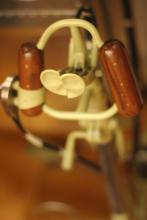 Slow flight and glides are stable and predictable, landings aren't too different from other tailskid aircraft with the exception of the cockpit/control stick layout which makes for a rather cramped position while flaring. The seat is an odd high back leather covered wrap around device that has seat belts designed to keep you from falling out only, not to protect you in the event of a mishap. The lap belt is designed to go over the seat and not even contact your thighs or lap. The high sides of the seat leave little room for your elbows when pulling the stick back , an awkward position but one you have to get used to. After landing, rollout is a bit touch and go if there is any wind, without a steerable skid or keel, the spoon shaped skid can drift off the straight and narrow if you let it get away.
Slow flight and glides are stable and predictable, landings aren't too different from other tailskid aircraft with the exception of the cockpit/control stick layout which makes for a rather cramped position while flaring. The seat is an odd high back leather covered wrap around device that has seat belts designed to keep you from falling out only, not to protect you in the event of a mishap. The lap belt is designed to go over the seat and not even contact your thighs or lap. The high sides of the seat leave little room for your elbows when pulling the stick back , an awkward position but one you have to get used to. After landing, rollout is a bit touch and go if there is any wind, without a steerable skid or keel, the spoon shaped skid can drift off the straight and narrow if you let it get away.
All in all it is a sexy sleek design that performs well but not quite as good as it looks!
